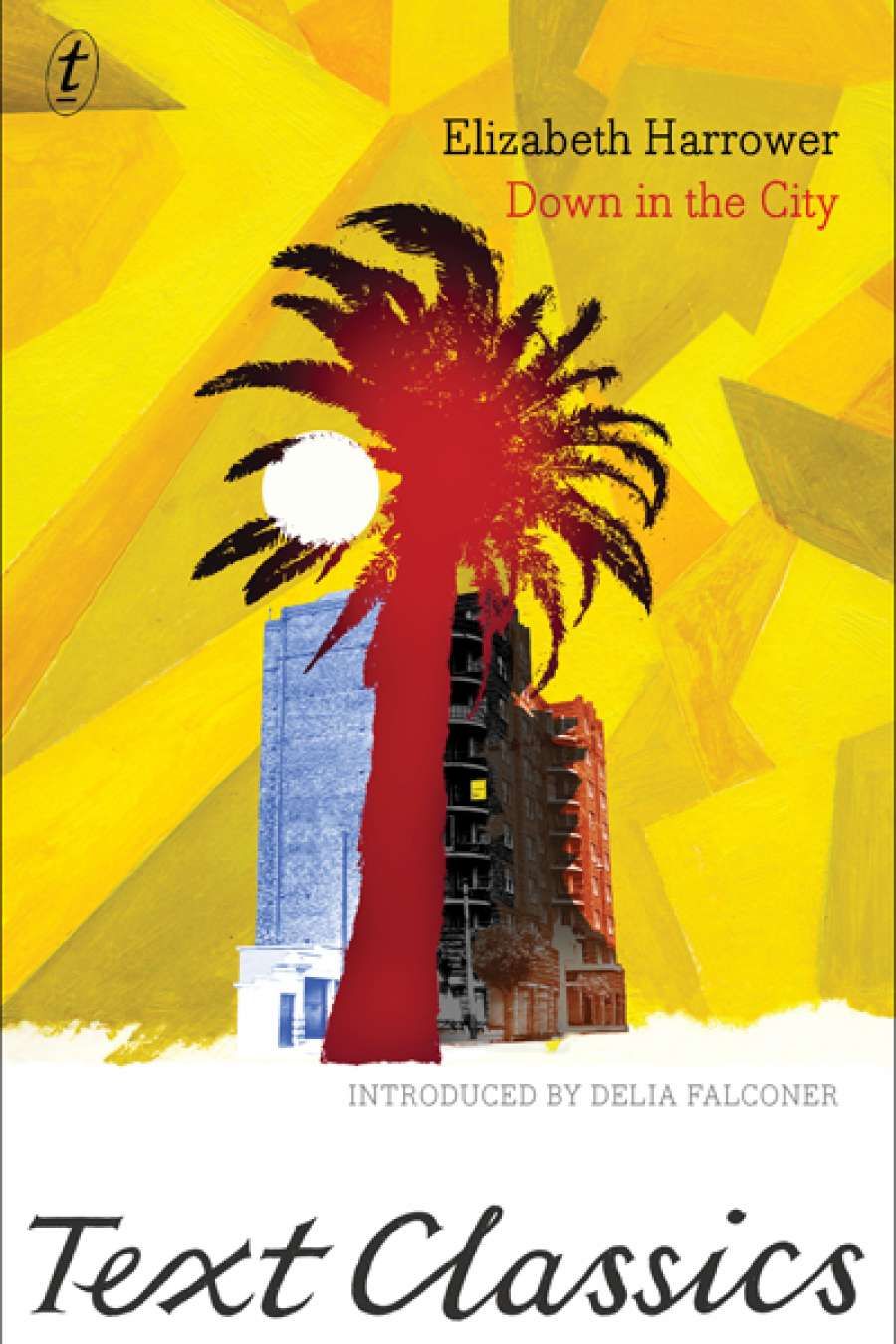
- Free Article: No
- Contents Category: Fiction
- Custom Article Title: Susan Sheridan reviews 'Down in the City'
- Review Article: Yes
- Article Title: Bright and wicked
- Online Only: No
- Custom Highlight Text:
Elizabeth Harrower’s début novel was first published by Cassell in London in 1957. Down in the City begins with a hymn to Sydney, with its beaches, harbour suburbs, city arcades – and disreputable Kings Cross, ‘a haven for the foreigner and racketeer; a beacon for long-haired boys, mascaraed women and powdered men. It is Montmartre: it is bright and wicked.’
- Book 1 Title: Down in the City
- Book 1 Biblio: Text Classics, $12.95 pb, 303 pp, 9781922147042
This evocation of the city where she had grown up signals the young novelist’s orientation towards a new kind of Australian fiction, set in contemporary urban society and focused on power relations between individuals. In the late 1950s and early 1960s it was joined by Dorothy Hewett’s Bobbin Up (1959), Thea Astley’s and Jessica Anderson’s early fiction, and Criena Rohan’s The Delinquents (1962) and Down by the Dockside (1963) – a small group of novels by women exploring the complexities of class, gender, and sexuality. They were set apart from both the still-dominant tradition of masculine social realism and the emerging metaphysical modernism practised by Patrick White and the young Randolph Stow. They were attempting something new, for which Australian precedents scarcely existed, except perhaps in the work of the great expatriate, Christina Stead.
Down in the City is a study of an abusive marriage, an extraordinary achievement for a writer who was still under thirty when she wrote it. Stan Peterson is a shady businessman about town: he is crass and vulgar in manner, unpredictable and violent when drunk, but apparently irresistible to women. Esther Prescott, the woman he marries after the briefest acquaintance, is the isolated and emotionally repressed daughter of a wealthy eastern-suburbs family. She is a blank page, taking pleasure only in sunbathing and shopping in the city. With Stan she begins to live intensely, but this heady change brings with it inescapably negative emotions. A cycle emerges – he attacks her, she attempts to appease, he apologises: ‘Esther wondered why anger and abuse should be so richly stimulating, why they should have the seal of genuine feeling, while sorrow and regret have the tasteless quality of watered milk …’
Changes in the emotional weather are accompanied by the changing Sydney seasons and the couple’s changing routines of pleasure – driving in the car, sunbathing by the harbour pool, going to the races, dining and dancing. Harrower’s narrative traces a pattern of repeated abuse and reconciliation, subtly suggesting the strong sexual passion that underlies it. But in the end Esther is blank and exhausted, resigned to the knowledge of Stan’s finally proven infidelity and her entrapment: ‘That she was she, that this was her one life, her past and future, she most tiredly knew.’
Two such characters caught in a sado-masochistic cycle will be familiar to readers of Harrower’s most admired novel, The Watch Tower (1966), and the less well-known The Catherine Wheel (1960). In Down in the City, Harrower portrays their isolation well, though she sometimes makes the mistake of switching the point of view to other characters without giving them a convincing inner life. These supporting roles are, nevertheless, interesting ones. They include some neighbours in the block of flats at Kings Cross: Laura Maitland, who mirrors Stan as a skilled manipulator; and seventeen-year-old Rachel Demster, who is at first under Laura’s spell, and comes to fill the role of the watcher, critically observing Esther and Stan. There is also Stan’s long-time publican girlfriend, Vi, a vivid presence and convincing voice. These portrayals of the young girl and the invincibly vital older woman would seem to be apprentice work for two of the central characters in Harrower’s second novel, The Long Prospect (1958).
Down in the City joins The Long Prospect and The Watch Tower in the Text Classics list – three of the four novels that this outstanding writer published over a ten-year period. And then she stopped. Except for a few short stories and a number of interviews (most recently with Ramona Koval for The Monthly), nothing more has been heard from Elizabeth Harrower since 1966. Yet the last novel, The Watch Tower, confirmed her reputation as a significant Australian voice of the period, and it is still widely admired for its unflinching examination of manipulative power relations between men, women, and children, in claustrophobic domestic settings.
Difficult relationships being her subject, it is possible that Harrower’s life ceased throwing up challenges of that nature, situations that demanded such intensive thinking-through. She has often stated her belief that a book has to need to be written, rather than be willed into existence because the writer wants to produce another title. Perhaps by the age of forty she had completed all the novels that needed to be written, springing from what she described as her ‘turbulent’ childhood and youth. In her maturity she seems to have had a great talent for friendship, and numbered Patrick White, Christina Stead, Sidney and Cynthia Nolan, Shirley Hazzard, Judah Waten, and Kylie Tennant among her friends. She describes herself as being sustained, as well, by literature, theatre, singing – and a lively interest in politics.
Yet her characters rarely experience such sustenance. They are enlivened by pain and the impulse to inflict pain on others; entrapped in their relationships, they see little of the outside world. But in this, her first novel, Harrower creates for them a wider social setting and a powerfully rendered sense of place. Delia Falconer, in her introduction to this edition, rightly describes Down in the City as being ‘in thrall to Sydney’, and I know of no better evocation of 1950s Sydney. It is a remarkable achievement.


Comments powered by CComment